How to Create Behavioral User Personas That Drive Better UX Decisions
Creating better user personas isn't just about demographics - it's about behavior.
In this guide, you'll learn how to build data-driven UX personas based on real-world cognitive biases.
Using real-world examples and a powerful free tool, I'll show you how to go beyond superficial characteristics and create behavioral personas that lead to smarter, more effective UX decisions.
What Is a User Persona: Research-Based Definition
So, let’s quickly summarize what a user persona is. A user persona is a semi-fictional character based on real data representing your ideal user/customer. It helps businesses deeply understand their users' needs, behaviors, motivations, and pain points.
The best user persona definition is: “A detailed profile that captures the goals, challenges, and demographics of a typical user, grounded in research and real-world insights, to guide product and marketing decisions.” By humanizing data, personas allow teams to build with empathy and clarity, ultimately creating more tailored experiences.
The Real Life Problem With User Personas
One of the biggest modern problems with user personas is their disconnect from behavioral science. While originally meant to humanize data and guide design or marketing decisions, many personas today are based on surface-level traits - like age, job title, or a generic quote - rather than grounded in how people actually think, decide, and behave.
This creates a false sense of understanding. Without integrating insights from cognitive psychology, behavioral economics, or decision-making theory, these personas become more like marketing avatars than tools for real empathy. The result? Products and campaigns that miss the mark because they’re built around assumptions, not human behavior.
This is how a typical persona looks like:
Name: Jim Jones
Age: 47
Occupation: Marketing Manager at a mid-sized tech company
Location: Austin, Texas
Education: Bachelor's in Communications
Tech Comfort Level: High
Goals:
Age: 47
Occupation: Marketing Manager at a mid-sized tech company
Location: Austin, Texas
Education: Bachelor's in Communications
Tech Comfort Level: High
Goals:
- Stay updated on marketing trends
- Improve team collaboration
- Increase lead conversions through smarter tools
Challenges:
- Too many disconnected platforms
- Struggles to analyze campaign ROI
- Limited time to explore new tools
Motivations:
- Wants to be seen as innovative at work
- Values time-saving, user-friendly tools
- Appreciates personalized customer support
Quote: “I need marketing tools that work together and give me clear insights fast.”
Technically speaking, yeah, this is a persona. But in fact, such a persona gives a poor understanding of which direction the team should take while working with them. When a newcomer joins the team and tries to use this persona, most of his hypotheses are parried by colleagues with “yes, but”, “it is written so, but in fact”, and “you need to talk to the users to understand them”. At some point, the persona loses any meaning and becomes just an inoperable skeleton in the team’s closet.
Why Personas Aren’t As Efficient As They Should Be
The issue is simple: most personas lack a core understanding of behavioral and cognitive patterns. Take the example above - knowing that Sarah Mitchell is a 34-year-old marketing manager tells you nothing about how she sees herself or the world. Is she conservative in her thinking? Narcissistic? Overconfident? Does she believe the world is fundamentally fair? Does she rely too much on automation, or chase novelty as a signal of value?
These questions might seem abstract, but each points to a cognitive bias - conservatism bias, illusory superiority, overconfidence effect, Dunning-Kruger, just-world fallacy, automation bias, novelty bias, and so on. These are not small details; they shape how people make decisions.
Many talented individuals intuitively grasp this - they can feel these patterns - but that knowledge often remains internal and hard to communicate. Even when teams want to explore the behavioral layer of their users, there’s a lack of structured tools or frameworks to help them map it out effectively.
UX Core Persona: A Tool for Creating Behavior-Based UX Personas
With this in mind, we’ve built a tool called UXCP - a behavioral-first approach to persona creation.
UXCP helps you construct user personas by actively engaging with a library of cognitive biases. Whether you’re working solo or with a team, the tool guides you through a structured process where you select relevant thinking patterns that align with your persona’s worldview and decision-making style.
All functionality lives on a single, intuitive webpage: start by naming your persona, then browse through a curated list of cognitive biases (shown in blue on the left). Hovering over each reveals a short description, and with a single click, you can add those that resonate with your character. The result is a richer, behaviorally anchored persona that goes far beyond surface traits.
UXCP is free, like everything else we create at keepsimple.io - give it a try: https://keepsimple.io/uxcp.
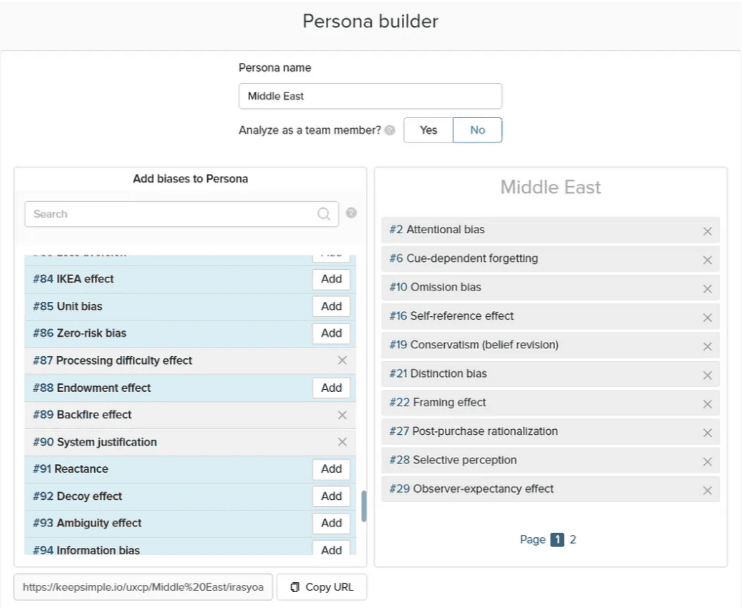
Once you’re done building your persona in UXCP, you can simply share the link with your team - and that’s it. No exports, no presentations, no extra effort. This lets others see the persona exactly as you envisioned it, including the cognitive layers that shaped your decisions. It’s a form of deep knowledge sharing that goes far beyond bullet points or vague summaries.
By aligning your team around how a persona thinks, not just what they do or what they look like, you open the door to a whole new level of clarity. In many cases, this kind of shared understanding can boost the quality of collaboration and decision-making by orders of magnitude.
But that’s not all.
UXCP Tool Review: Features That Bring User Personas to Life
Product Insights Section
While persona stays the same, but the questions you need to solve change depending on your product stage. That’s why UXCP includes five key stages: Team forming, Development, Pre-signup (marketing), Post-signup (actual product use), and Analytics. After you’ve built your persona by selecting cognitive biases, you can choose the stage you want to focus on.
While persona stays the same, but the questions you need to solve change depending on your product stage. That’s why UXCP includes five key stages: Team forming, Development, Pre-signup (marketing), Post-signup (actual product use), and Analytics. After you’ve built your persona by selecting cognitive biases, you can choose the stage you want to focus on.
The tool will then highlight the most important questions for that stage - based on the biases you picked. Click on any question to explore at least eight possible answers, each linked to a specific cognitive bias. This helps you clearly see what matters most and how to act on it.
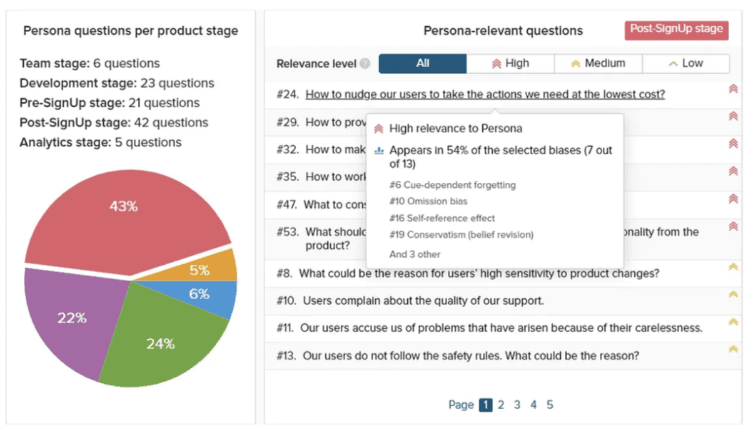
Technically speaking, this feature lets you peek into potential future issues and address them early - by embedding solutions directly into your design long before those problems ever surface.
Suggested Questions Section
Here, the system also suggests additional questions that didn’t directly match your persona’s biases - but are still worth exploring, as they’re closely related to the ones that did. These can reveal hidden patterns or edge cases you might otherwise miss.
Here, the system also suggests additional questions that didn’t directly match your persona’s biases - but are still worth exploring, as they’re closely related to the ones that did. These can reveal hidden patterns or edge cases you might otherwise miss.
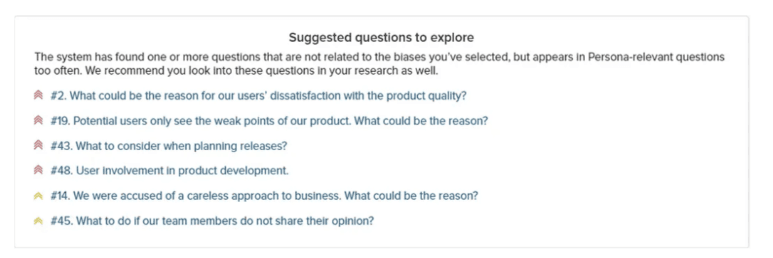
Decision Table Section
The next section is called the “Decision Table.” Here, you can see the list of biases that you’ve identified above, alongside the area where you can write your action plan for each cognitive bias.
The next section is called the “Decision Table.” Here, you can see the list of biases that you’ve identified above, alongside the area where you can write your action plan for each cognitive bias.
The goal is simple: to ground your business, product, design, or UX decisions in behavioral reasoning - not just intuition or gut feeling. By tying each decision back to a specific bias, your ideas become harder to dismiss and far more persuasive - because they’re rooted in how people actually think.
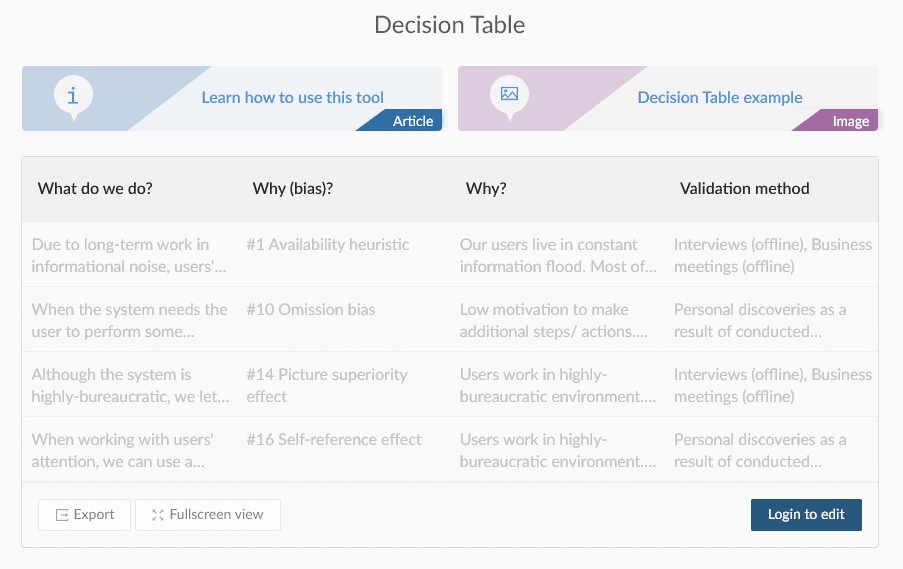
Instead of going into long explanations of this part, I’ll just show an example. This is an example of Persona used to design an 8-digit $ worth governmental ERP system for the Middle East: (Link to .png file)
Bonus Section: Team Member Insights Section
UXCP can be used not only to analyze your Product Persona, but also to analyze someone as a team member. If you check the checkbox at the top of the tool (Analyze as a team member? “Yes”), the system will check the biases you’ve mentioned for insights related to team dynamics.
UXCP can be used not only to analyze your Product Persona, but also to analyze someone as a team member. If you check the checkbox at the top of the tool (Analyze as a team member? “Yes”), the system will check the biases you’ve mentioned for insights related to team dynamics.
Bonus Section: Team Member Insights Section
UXCP can be used not only to analyze your Product Persona, but also to analyze someone as a team member. If you check the checkbox at the top of the tool (Analyze as a team member? “Yes”), the system will check the biases you’ve mentioned for insights related to team dynamics.
UXCP can be used not only to analyze your Product Persona, but also to analyze someone as a team member. If you check the checkbox at the top of the tool (Analyze as a team member? “Yes”), the system will check the biases you’ve mentioned for insights related to team dynamics.
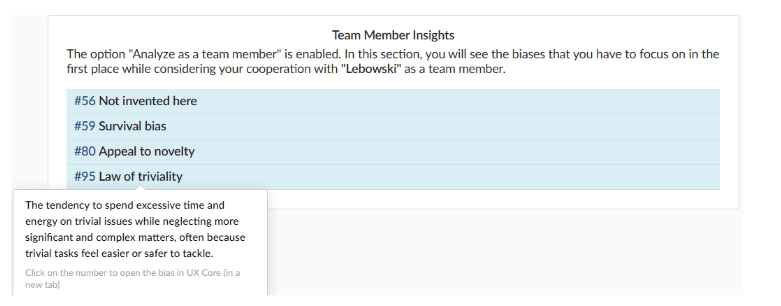
Summary
At its core, UXCP is a one-of-a-kind tool for smart teams who want to make even smarter and grounded evidence-based decisions - not just the loudest voice in the room or the opinion of the highest-paid person.
Like the rest of the UX Core toolkit, UXCP empowers teams to justify UX and product decisions through the lens of cognitive science. It amplifies the voices of those closest to the user, strengthens collaboration, and helps high-performing teams operate with greater clarity and precision.
Because, in the end, it’s not about opinions - it’s about understanding how people actually think and using that to make every decision count.
Thank you,
Wolf Alexanyan
Wolf Alexanyan
F A Q
- Question: How do you ensure that selecting cognitive biases doesn't become just another checklist activity - subject to the same “surface-level” misuse the article criticizes in traditional personas?
Answer: I do not. As with any other smart tool, this thing should be supervised by the higher management who can understand and extrapolate its value to the rest of the team.
- Question: Could anchoring personas to cognitive biases unintentionally reduce flexibility in thinking - by framing users too narrowly within predefined psychological patterns?
Answer: Similarly to how people nowadays use ChatGPT, if they go in blind without understanding the output, it’ll damage their decisions, damage their business, and eventually put their positions at risk. The topic of cognitive biases is too nuanced to do without a high level of attention. And yes, if all your attention is in cognitive biases, you might lose touch with reality - that’s why UXCP is recommended as a team activity.
- Question: How do you validate that the selected biases actually correspond to the user’s behavior in real-world scenarios rather than just appearing theoretically relevant?
Answer: The validation part is being handed over to those who compose the Persona. The same is being done by big corpos such as Google, Meta, Apple, Amazon etc.
- Question: Does tying product decisions to cognitive biases risk overcomplicating the design process for teams without formal behavioral science training?
Answer: At the end of the day, all the existing teams, be it growth, product, traditional marketing, or BD, operate with behavioral sciences. UXCP just frames it more clearly, making it available for the broader teams.
- Question: How scalable is UXCP for rapidly evolving products or fast-moving teams - where user behavior shifts quickly, and biases might not stay relevant over time?
Answer: It is well-known that Persona can, and must evolve. The same goes with updating Persona in UXCP. Although, the good news is that in cognitive science, Persona often changes with the market, but not within the same market.

